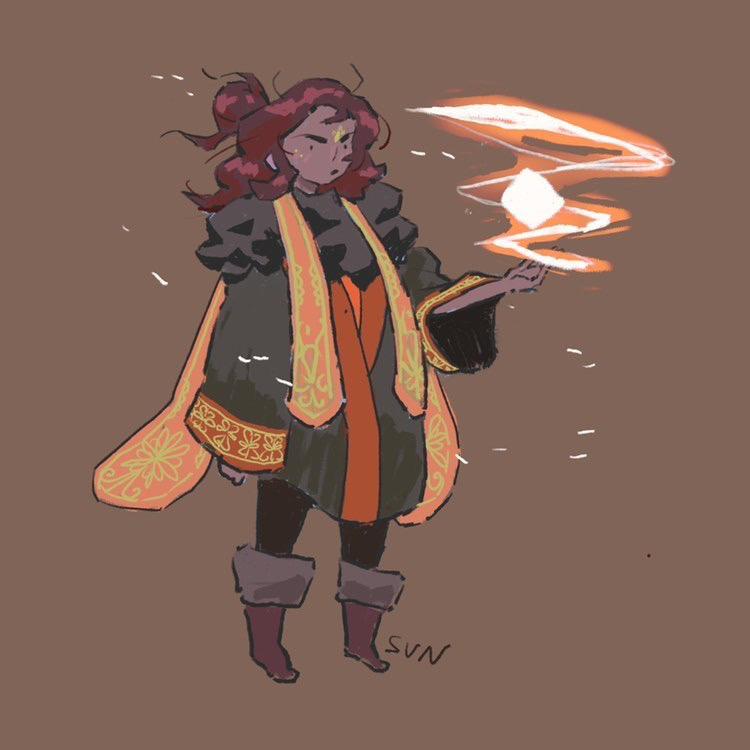The Ashavas is a small shrub that is found in the mountainous regions on
Mars. Like most surface species it has a distinct reddish hue on its trunk and limbs. Despite the harsh environment the plant is surprisingly well adapted to the low nutrient soil and high temperatures. The plant is mostly carnivorous although it is one of the few carnivorous species that live on the surface of Mars. Unlike its subterranean cousins, the Ashavas' red coloring is derived from the high amount of iron in the soil instead of the blues and greens used by other species. Its red branches glisten almost ethereally in sharp contrast with its arid environment. The plant is covered with a clear gel that helps feed the plant and protect it from the sun. It appears as if the plant has been perfectly encased in crystal giving it an otherworldly appearance.
These plants are highly sought after in
Martian culture and are the subject of many ancient myths. Given the remoteness of its native range it must have appeared like a glorious salvation to a thirsty traveler. However, anything that manages to survive on the surface of Mars is no easy target. The plant itself produces a powerful neurotoxin that can easily kill a full grown Martian if ingested. Rather it is the fruit of the plant that is truly the salvation of a weary traveler. The mountains are a deadly environment and the Ashavas have not survived by chance. Much like Mars itself it is the perfect mix of beauty and cold blooded survival.
Basic Information
The Ashavas is a shrub tree that has a single trunk that separates into several branches. The bark of the plant has a reddish hue because of the minerals it takes from the soil. The shrub's trunk and branches are coated in a thick, clear gel that helps the plant to reduce water loss. The gel also helps the plant absorb water from the air at night. If one is fortunate enough to see the sun set in the presence of Ashavas the kaleidoscope of light dancing on the mountain side is said to be one of the most mesmerizing natural events. The plant anchors itself to the hard dirt and stone with a small tapered root system that is able to crush stone with its persistence. The plant has small, oval shaped leaves that cluster on the last six inches of the branches. The leaves furl when the sun is at its most intense and unfurl when the risk of damage is passed. The leaves are pale green which is highly unusual among the flora of Mars.
The Ashavas is capable of asexual reproduction when no other members of the species are present. It is very resistant to inbreeding depression and can reproduce asexually for many generations before any ill effects appear. When other plants are present the plants release clouds of pollen that fertilize the flowers on other trees allowing for sexual reproduction. This pollen is usually released later in the afternoon of evening at which time the flowers open fully. The flowers close during the hottest parts of the day to avoid being scorched. The plant produces small white flowers that give off a sweet scent. These flowers cluster on the end of the branches nestled among the leaves creating a rare patchwork of white and pale green. The scent helps attract prey so the plant has enough nutrients to put toward growing the fruit. The Ashavas produces a medium silvery fruit that is highly nutritious it help the seeds survive in a nutrient poor environment. The shrub only produces fruit once every seven years.
When an Ashavas seed germinates it undergoes a period of rapid growth. The plant only has a limited amount of time to make use of the water and nutrients stored with the fruit. Once the plant has established itself its growth slows significantly. Despite having a lifespan of a few hundred years, the trunk and branches are rarely more than 15 to 20 inches in diameter. The plant does not start producing its gel coating until it passes the sapling stage. Once the initial nutrients from the fruit have been used up the plant starts producing the gel coating to sustain itself.
The Ashavas is only found in the dry mountain regions of Mars. It is usually found at high elevations preferring slightly shaded locations. Due to its rarity, further information about preferred habitat is speculation a best. The shrub is highly endemic and is very difficult to cultivate. Current no known attempts at cultivation have been successful.
Although the Ashavas is a plant species, the harsh nature of its environment means that it is unable to survive solely on nutrients in the soil. The dry mountain soils don't have enough water and nutrients available to support the Ashavas. So the plant instead uses the clear gel coating its limbs to supplement nutrition for the plant. The thick sticky gel is used to trap insects and small animals. The gel contains a powerful neurotoxin that paralyze and kill the animal. The gel insures that the animal remains trapped on the plant while the digestive enzymes in the gel slowly break down the food for the plant to absorb.
Additional Information
It is possible with extreme care to harvest the gel coating the branches. The gel could them be used to poison foes or be applied to weapons although such a tactic is considered cowardly among Martian warriors. It is not advised to harvest more than a small amount from each tree so as not to risk harming such a rare species. The main reason the shrub is so highly valued by Martians is for its fruit. According to ancient legend eating the fruit of the Ashavas bestows the blessing of
Ta-Ulak the Great Protector. Legend says that those who eat the fruit become nearly impossible to wound in battle so strong is the god's blessing. The fruit has the ability to harden the scales of a Martian making them more resilient to both blunt and cutting force. Due to the rarity of the fruit most of the information surrounding its effects have faded into myth and some claims have been exaggerated.
One of the more well known myths is the story of Ta-Ulak and the Deciever. In this myth Ta-Ulak is tricked by Leshot the deceiver into traveling into the desert mountains. There Leshot attacks Ta-Ulak and manages to mortally wound him. Ta-Ulak is left for dead under the branches of the Ashava tree. The Ashavas takes pity on Ta-Ulak and gives him her only fruit to save him. In return for saving his life, Ta-Ulak blessed the plant and gave it the ability to defend itself in the form of its toxin.
Found in the mountain ranges on Mars, the Ashavas is extremely rare and there are currently only a handful of known locations. Very little is known about the distribution of the species although it is likely planet wide due to its influence on every branch of Martian culture. Exploration to find more places where the Ashavas grow is ongoing but difficult due to the risk of dying to mountain predators.
Scientific Name
Coruscis letum
Cultural Significance
Despite the dangers of searching for such a plant, Martian culture has traditionally gone to great lengths to procure the Ashavas fruit. In ancient times a ritual called the
Val-Shavel was used to test the worthiness of tribal heirs. Individuals were sent into the wilderness in search of the Ashavas fruit for a period of one year. Returning early resulted in dishonor and disqualified the heir from succession. Most heirs that participated spend the year surviving in the wilderness and were able to return without consaquence.
Those few individuals that ended up finding the fruit were often able to unite various tribes into a larger kingdom during their lifetime. These kingdoms did not usually last past the death of the king due to infighting among the tribes. In the current time the tradition of the Val-Shavel lives on although it differs regionally in practice. In most places the Val-Shavel is undertaken by warriors at the command of their ruler. In other places the Val-Shavel is an exile sentence for criminals who will only be able to return to society if they find the fruit.
Amino Iron
The Ashavas plant is unique because it is able to alter the iron it takes in from the soil. Despite the extreme amounts of iron on Mars most plants and animals that take it in either store it, which usually results in a reddish tint in coloring, or excrete it as waste. The Ashavas is unique because it alters the iron oxide it takes in and combines it with several key amino acids. The resulting Amino Iron is then stored in the fruits to sustain the seedlings.
If a Martian consumes the fruit their body is actually able to use this processed form of iron. The compound is similar to what is used in the maintenance of scales to preserve the integrity of the outer armor. This processed iron serves to further reinforce the scales making them much stronger and more difficult to penetrate. However, once the iron reaches the scale the amino acids are detached and used for other body processes, while the iron remains permanently in the scales. It is this strengthening effect that has led to the legends of the Ashavas providing the blessings of the god of protection. Due to its rarity extensive use of the fruit has never been feasible leading to the survival of the myths and traditions surrounding the plant into the modern era.














This is an interesting plant! I like how you've adapted it for the Martian environment and how you've integrated it into the Martian culture. Here are a few notes I took while reading the article: Your paragraphs in the sidebar are very long, it would help make the reading easier if you break them up in smaller paragraph. The starting paragraph in the main text can also be cut into two starting from " These plants are highly sought after in Martian culture" since this is the start of a new idea. In the other section, it would also be helpful to start a new paragraph for each new idea. "The plant is mostly carnivorous although its coloring is derived from the high amount of iron in the soil." You need to tell us why it is surprising for the plant to have that colouring first. What colour is expected of carnivorous plants? And it would also help if you mention the colour of the plant before that sentence and not after. You say that the pollen is absorbed by the gel, but the gel is not on the flowers. The pollen needs to get inside the ovules that are in the flowers. Do you know how does it go there? "the harsh nature of its environment means that it is unable to survive on nutrients in the soil." I think you need to add an "only" here, since your plant does take some nutrients from the soil but it's not enough for it. Or does it take absolutely no nutrient? If that's the case, you can clarify that. "Legend says that those who eat the fruit become nearly impossible to wound in battle so strong is the god's blessing." What does the fruit do exactly to the people who eat them? Do they have impenetrable skin? Heal from any injury? Are stronger and faster? "only a handful of sightings have ever been confirmed." Are you talking from the POV of the Martians or of someone from Earth? It it's from someone from Earth, I think you need to say it clearly here as I'm getting a bit confused otherwise. You could also present the whole article as a report from a scientist from Earth if you want to have fun with that. In your sidebar, I would put the name, lifespan, height and distribution at the top, then add a header saying something like "cultural impact" and one for "Iron processing". Ah I see that that last paragraph in the sidebar did answered some of my question. Still I think the effect of the fruit should be mentioned in the main text too. If the iron compound is a real life chemical, you could add its name there- if it's not a real one, you could invent a name for it. I like that chemistry bit to explain the effect of the fruit :D
Thank you for your advice. I appreciate the detailed notes and have been able to improve my article accordingly. Thank you for taking the time to read my work.